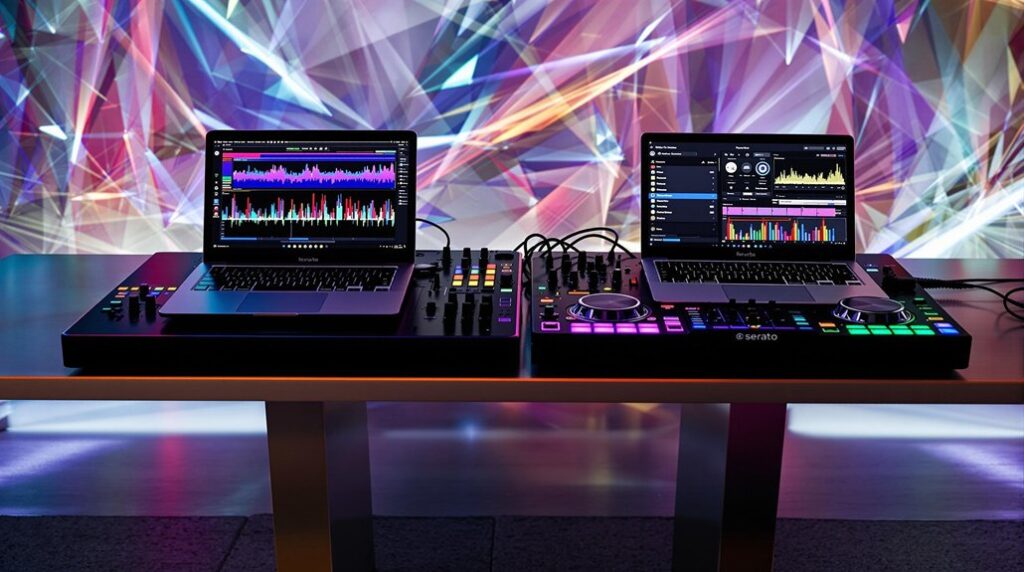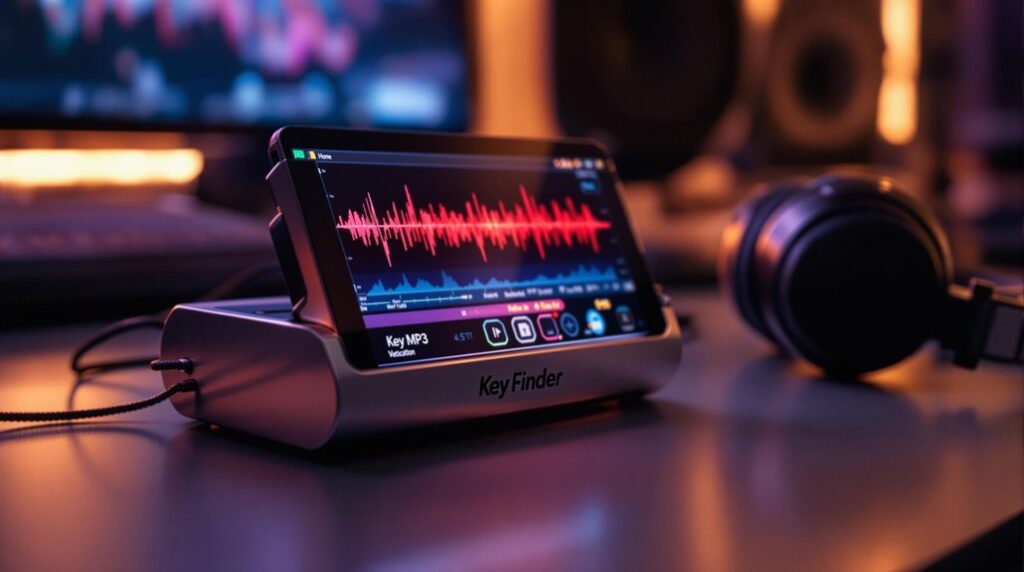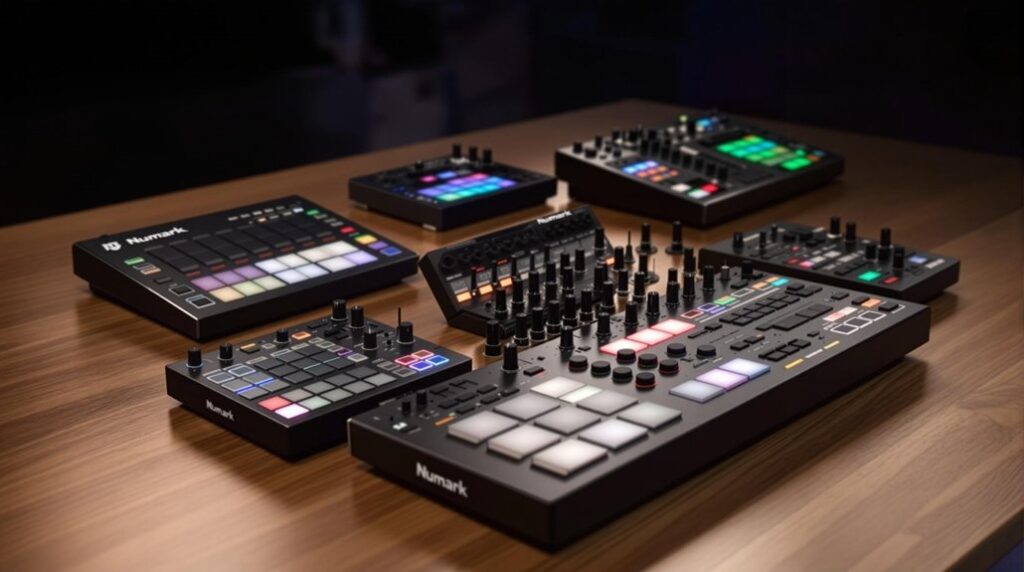Musicians and DJs utilize key and BPM finder tools to harmonize their mixes, facilitating seamless changes and energetic flow. These tools, such as Mixed In Key and Captain Plugins, provide advanced analysis using machine learning to guarantee precision in detecting key, BPM, and additional features like danceability and energy. Supported formats like MP3, WAV, and FLAC enhance the reliability of results, keeping artistic visions intact. Release the potential of coordinated, cohesive sets and raise music production to new heights.
Key Takeaways
- Key and BPM finder tools enhance harmonic mixing by ensuring seamless transitions and compatibility between tracks.
- Machine learning algorithms analyze audio features to accurately detect key and BPM for precise beatmatching.
- Tools like Tunebat and Mixed In Key offer advanced features for key detection and energy evaluation.
- Audio files in formats like MP3, WAV, and FLAC can be analyzed locally for privacy and efficiency.
- Sentiment analysis metrics like energy and danceability are integral for creating engaging and cohesive DJ sets.
Understanding the Role of Key and BPM in Music
In the sphere of music production, the key and BPM of a composition are paramount elements that define its structural and emotional landscape. The key, a harmonic framework centered around a tonic note, imbues the music with its intrinsic tonality and mood. BPM, or beats per minute, quantifies the tempo, dictating the flow and energy of the track. These metrics are vital for musicians and DJs, enabling seamless shifts, harmonization, and transposition. Harmonic mixing ensures tracks are harmonically compatible, enhancing the overall flow of a DJ set. Genres exhibit distinct BPM ranges, with Dub spanning 60-90 BPM and Hip-Hop at 60-100 BPM. Utilizing a key finder tool alongside BPM analyzers enhances musicianship, allowing for precise beatmatching and crafting cohesive playlists. Such tools are indispensable for creating a harmonious auditory experience.
Steps to Use a Key and BPM Finder
Uploading an audio file to a key and BPM finder initiates a critical process for musicians and producers seeking precision in their craft. Commencing with the selection of supported formats like MP3, WAV, or FLAC, users effortlessly transfer their audio to the tool's designated area.
The analysis, a sophisticated algorithmic operation, unfolds automatically within the browser, negating the need for external file transfers. Upon completion, results surface in a structured table, revealing the key, BPM, and auxiliary metrics such as energy and danceability.
Users can download these insights, facilitating archival and collaborative endeavors. Through utilizing the identified key and BPM, producers deftly find the tempo, harmonizing their mixes with artful finesse, ensuring a seamless auditory experience devoid of discordant tones.
How the Browser-Based Analysis Works
Harnessing cutting-edge algorithms, the browser-based Key and BPM Finder executes local file processing to guarantee robust privacy safeguards, eliminating the need for data transmission to external servers.
By analyzing low-level audio features with machine learning, this tool not only mirrors the precision of commercial alternatives but also respects user confidentiality.
This privacy-focused technology empowers users with immediate insights into the sonic environment of their audio files, delivering thorough results without compromising on discretion.
Local File Processing
The intricate dance of local file processing guarantees that audio analysis occurs entirely on the user's device, safeguarding privacy and enhancing speed.
This browser-based method empowers users to find the key and BPM of their music with swift efficiency. Algorithms, crafted by the erudition of audio experts and PhD holders, explore low-level audio features with precision.
The moment an audio file—be it MP3, WAV, FLAC, AAC, OGG, or M4A—is uploaded, the analysis commences automatically, presenting results in a structured tabular format.
Users experience a seamless journey, unencumbered by official file size constraints, though performance may hinge on the intricacy of both hardware and algorithmic complexity.
This method offers versatile options for diverse audio formats.
Privacy-Focused Technology
While safeguarding user privacy stands as a paramount concern, the browser-based analysis for key and BPM detection ingeniously circumvents data transfer to external servers.
This Key Finder tool leverages advanced algorithms, meticulously crafted by audio experts and PhD holders, ensuring audio files remain securely on the user's machine. By extracting low-level audio features locally, it provides an intricate understanding of musical elements, resulting in precise key and BPM estimates.
The underlying technology, powered by continually evolving machine learning models, enhances the precision of sentiment analysis metrics such as energy, danceability, and happiness.
Supporting formats like MP3, WAV, FLAC, AAC, OGG, and M4A, users can confidently analyze their audio files without compromising privacy, achieving harmonious mixing with unparalleled assurance.
The Importance of Accurate Detection Algorithms
How vital is the precision of detection algorithms in the domain of music production? In this intricate sphere, accurate algorithms are fundamental for identifying the Song Key and BPM, necessary for DJs and producers crafting harmonious mixes. These algorithms meticulously examine low-level audio features, parsing frequency content to pinpoint predominant pitch and tempo, therefore directly affecting creative output. Serato DJ Pro is known for its real-time track analysis, which is crucial for precision in beat matching and ensuring synchronization of beats. Variability among detection algorithms means different tools might produce disparate results, making multifaceted analysis essential for verification. Training machine learning models on extensive datasets further refines accuracy, predicting musical features like energy and danceability with heightened precision. Ultimately, the accuracy of these algorithms is vital in harmonizing tracks, advancing music production's creative setting.
Exploring AI and Machine Learning in Music Analysis
Artificial intelligence and machine learning have revolutionized music analysis by providing sophisticated tools for audio feature extraction and evaluation. By utilizing vast datasets of historical audio, AI-driven models accurately extrapolate key and BPM, enhancing music understanding.
Advanced algorithms crafted by audio experts precisely extract low-level audio elements, thereby refining the analytical acumen of these systems. As machine learning continuously adapts, the precision of key and BPM detection evolves, ensuring robustness in new audio assessments.
The integration of AI streamlines musicians' workflows, automating intricate tasks like harmonic mixing and mashup creation. This technological synergy not only facilitates efficiency but also empowers producers with data-driven insights, fostering innovative auditory compositions and harmonically cohesive mixes within the dynamic environment of music production.
Sentiment Analysis: Energy, Danceability, and Happiness Metrics
Building on the capabilities of AI in music analysis, sentiment analysis emerges as a vital component in understanding a track's emotional nuances. By utilizing advanced algorithms, it quantifies energy, danceability, and happiness metrics, offering a multi-dimensional view of musical expression.
Energy levels are a quantifiable measure of intensity, reflecting dynamic instrumentation and vigorous tempos, essential for energizing listeners and dance floors alike.
Danceability, calculated through tempo, rhythmic stability, and beat strength, serves as a key metric for DJs, guaranteeing seamless set shifts.
Happiness metrics, derived from tonalities and tempo, guide artists in crafting resonant, uplifting music.
Continual refinement through machine learning guarantees these models evolve, enhancing predictive accuracy as they assimilate burgeoning datasets of labeled audio compositions.
Dynamic effects create anticipation and excitement, keeping audiences hooked and engaged.
Advantages of Using Tunebat Analyzer Pro
Tunebat Analyzer Pro revolutionizes music analysis with its extensive suite of premium features designed for DJs and producers. Offering a cost-effective monthly subscription at $7.99 or an annual plan at $2.99/month, it provides enhanced tools for seamless key finders and precise BPM (beats per minute) detection. This allows users to streamline their workflow, free from ad interruptions. The platform's advanced sentiment analysis encompasses energy, danceability, and happiness metrics, enabling users to intuitively assess a track's emotional environment. In addition, the ability to save and download analysis results guarantees efficient catalog management. Customizable configurations cater to individual requirements, optimizing analytical processes. Tunebat Analyzer Pro stands as an indispensable asset, merging technical prowess with tailored user experiences, enhancing music production and performance. DJs benefit from genre diversity in their music libraries, ensuring they can cater to a wide range of audience preferences and maintain a dynamic selection.
Mixed In Key Software for DJs and Producers
Mixed In Key software is a cornerstone tool for DJs and producers, renowned for its precision in key detection and energy level evaluation, which greatly enhances the harmonic mixing process.
This software simplifies the mixing workflow by offering accurate analysis of both the key and tempo of a song, helping DJs maintain a seamless flow and energy in their sets.
Trust in its capabilities is reflected by its adoption by industry stalwarts like David Guetta and Armin van Buuren.
- Power Block Mixing: Keeps energy levels consistent across tracks, ensuring listener engagement.
- User-Friendly Interface: Streamlines the learning curve for both novices and veterans in the industry.
- Endorsement by Artists: Validates its effectiveness in real-world live performance scenarios.
Mixed In Key remains indispensable for quality-driven music creation.
DJs can leverage harmonic mixing to create emotionally impactful and cohesive sets, which is facilitated by the software's accurate key detection capabilities.
Exploring Features of Captain Plugins and Platinum Notes
While innovation continues to drive music production, Captain Plugins and Platinum Notes stand out as essential tools for modern producers seeking to refine their craft.
Captain Plugins empowers users by offering an intuitive platform to craft Chord Progressions, Hooks, Melodies, and Basslines, seamlessly integrating into DAWs. This allows producers to manipulate Key and BPM with ease, enhancing creative workflows and expediting the songwriting process. Its capability to export compositions directly to DAWs streamlines production, making it a quintessential asset for composers.
Conversely, Platinum Notes hones in on audio fidelity, ensuring every music file achieves pristine sound quality. With a focus on user-friendly adjustments, it caters to producers aiming to uplift production values effortlessly.
Together, these tools fortify a producer's creative arsenal, balancing technicality with artistry.
Benefits of Harmonic Mixing for DJs
Harmonic mixing revolutionizes a DJ's set by enabling seamless key shifts, thereby ensuring that tracks blend with an organic fluidity that captivates the audience. This technique enhances mix cohesion, mitigating the risk of jarring key clashes that can disrupt the sonic narrative and diminish crowd engagement. By utilizing the Camelot Wheel, DJs can easily identify compatible musical keys and prioritize key compatibility when selecting tracks, leading to smoother transitions and a more cohesive sound.
Seamless Key Transitions
In the field of DJ performance, fluidity is the art of crafting seamless shifts that enchant audiences and sustain the rhythmic momentum on the dance floor. By utilizing harmonic mixing, DJs blend tracks through compatible song keys, employing the Circle of Fifths to identify complementary keys. This technique allows for smooth key changes, maintaining the energy and tempo during sets.
Tracks in identical or related keys, such as C major and A minor, can be interwoven effortlessly, reducing awkward key alterations and guaranteeing a vibrant auditory experience.
- Enhances DJ sets by minimizing disruptive changes.
- Encourages prolonged engagement through harmonic fluidity.
- Utilizes software for precise key and tempo analysis.
Professional DJs harness these tools to guarantee their mixes are both harmonically sound and sonically enchanting.
Enhanced Mix Cohesion
Mastering the art of harmonic mixing enhances a DJ's ability to craft sets that resonate with audiences on both an emotional and auditory level. By strategically blending tracks in compatible keys and tempos, DJs achieve an unparalleled mix cohesion that captivates listeners.
Utilizing tools like key and BPM finders allows DJs to pinpoint songs that harmonize seamlessly, thereby minimizing tonal clashes and optimizing the auditory experience. Studies affirm that harmonic mixing not only increases listener engagement but also injects dynamic energy into the performance.
This technique, grounded in music theory, showcases a DJ's sophisticated creative expression. As a result, harmonic mixing facilitates smoother changes, resulting in seamless, longer mixes that sustain momentum, ensuring the dance floor remains electrified throughout the event.
Supported Audio Formats and File Considerations
The versatility of key and BPM finder tools is amplified by their support for an array of audio formats, including MP3, WAV, FLAC, AAC, OGG, and M4A. This expansive support enables users to conduct precise BPM (beats per minute) analysis across diverse music files, thereby enhancing their understanding of musical composition.
Each format offers unique benefits: MP3 files streamline quick analysis for DJs curating playlists, while WAV files provide superior audio fidelity for studio-grade scrutiny.
- MP3: Ideal for rapid BPM detection and playlist organization.
- WAV: Preferred for professional, high-fidelity audio analysis.
- FLAC: Guarantees lossless audio quality, suitable for detailed examination.
No official file size cap exists, though system performance hinges on computational power and algorithmic efficiency, guaranteeing peak audio analysis accuracy.
Frequently Asked Questions
What Are the Best Free Key and BPM Finder Tools Available?
When evaluating free key and BPM finder tools, industry insights suggest prioritizing ones with the best features like accuracy and user-friendliness. User reviews often highlight Tunebat and Mixed in Key as top contenders for effective musical analysis.
How Do Key and BPM Finder Tools Handle Live Recordings?
Key and BPM finder tools utilize sophisticated algorithms for live analysis, seamlessly extracting audio features from live recordings. This audio extraction process is essential for accurately determining dynamic tempo fluctuations and tonal shifts in an unpredictable live environment.
Can These Tools Integrate With Popular DJ Software?
The query regarding software compatibility addresses whether these tools possess integration features with popular DJ software. Industry insights reveal advanced algorithms facilitating seamless embedding, enhancing performance capabilities through creative expression and technical precision, optimizing the DJ's workflow.
Are Mobile Apps Available for Key and BPM Detection?
Mobile apps for key and BPM detection boast advanced mobile app features, offering real-time analysis. Accuracy comparison reveals these apps rival desktop counterparts, utilizing machine learning algorithms for enhanced precision, empowering users to seamlessly integrate harmonics into their creative process.
Do Key and BPM Finders Work With Classical Music Tracks?
Classical music presents intricate tempos and key modulations, posing challenges for detection accuracy. Key and BPM finders, utilizing advanced algorithms, enhance precision, yet complexities in classical compositions may still elude full automation, necessitating expert auditory verification for best results.
Conclusion
In the domain of music production, the precision of key and BPM detection tools underpins the seamless fusion of tracks. Through advanced algorithms and AI-driven analysis, these tools enhance the artistry of harmonic mixing, empowering DJs and producers to achieve sonic coherence. Software like Mixed In Key and Captain Plugins release creative potential, while supporting diverse audio formats guarantees adaptability. Ultimately, mastering these technologies raises the auditory experience, transforming rhythm and melody into a cohesive symphony.




